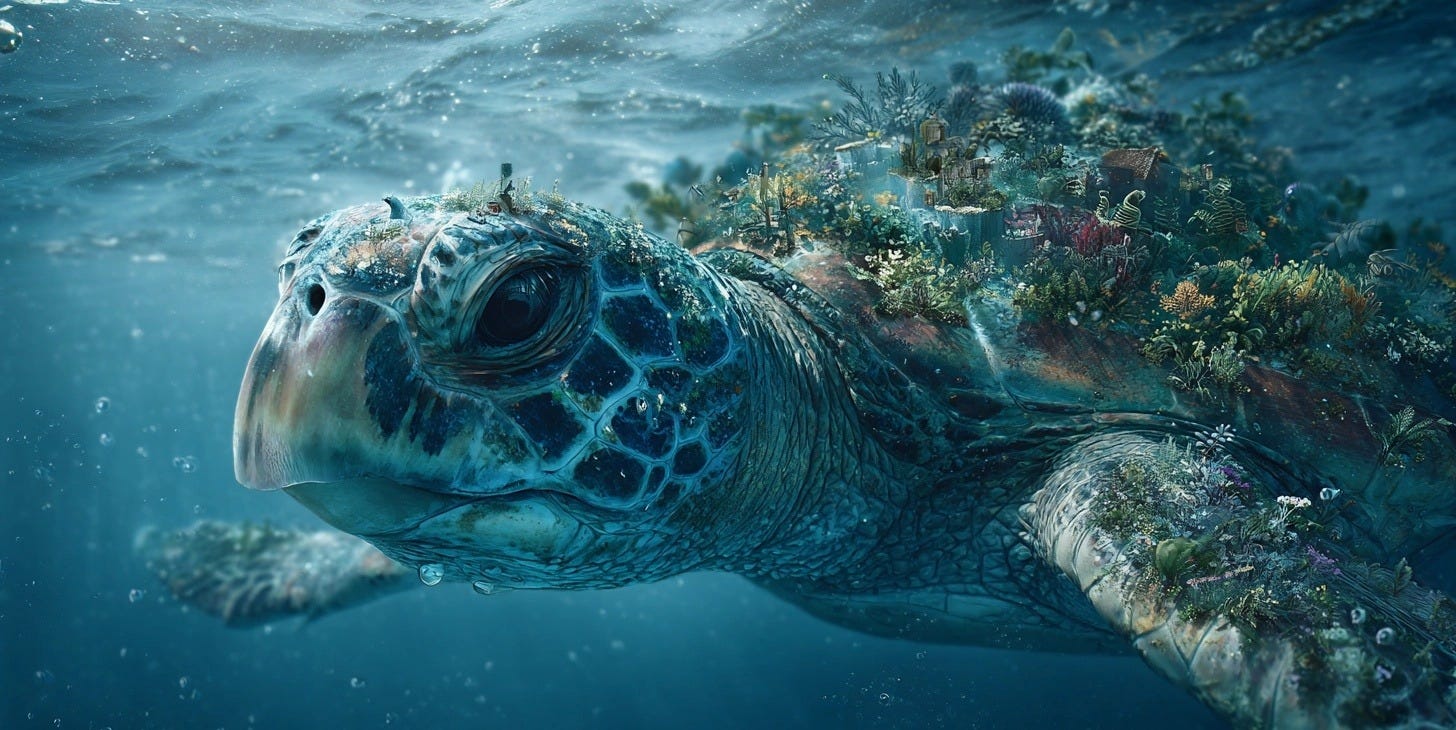We are tied to the ocean. And when we go back to the sea, whether it is to sail or to watch it – we are going back from whence we came.
John F. Kennedy
🧠 Technology
Quantum Computers Get 90% Energy Boost
A Canadian team has found a clever way to drastically cut quantum computing’s appetite for energy, using an innovative error-correction code. Nord Quantique’s new “Tesseract” approach combines bosonic qubits with multimode encoding to slash power use by up to 90% while shrinking system size. In a demo, their method solved a tough cryptography problem in one hour using just 120 kWh (versus 9 days and 280,000 kWh on a classical supercomputer). It’s a promising leap toward practical, greener quantum machines.
📖 Read More
Starship’s Fiery Triumph Moves Mars Dream Closer
Last week’s fourth Starship test flight may have ended in a spectacular breakup over the Indian Ocean—but SpaceX ticked off all its primary objectives before re-entry. For the first time, the 121-meter rocket reached orbital velocity, executed a propellant-transfer demo in space, and relit three Raptor engines for a controlled de-orbit burn—vital steps for future lunar and Martian missions. Elon Musk now gives “better than 50-50” odds of launching an uncrewed cargo Starship to Mars in the favorable 2026 window, noting that each rapid-iteration flight is shortening development timelines.
📖 Read More
DeepMind Chief’s Bold AGI Vision
Demis Hassabis, CEO of Google DeepMind, is being called the “most dangerous” tech leader alive — a nod to his extraordinary achievements and influence in AI. A child chess prodigy knighted for his AI work (and even a Nobel Prize winner), Hassabis predicts human-level AGI could arrive as soon as 2030. Crucially, his definition of AGI is lofty: a system that can do anything the human brain can, including true creativity and invention. With credentials like his, when Hassabis speaks about our AI future, the world listens in awe (and a bit of fear).
📖 Read More
AI Agents Hit $2K for Charity – Four AI agents were let loose online in an experiment to raise money for charity — and they managed to collect about $2,000 in a month. The “Agent Village” project gave each agent a computer and a goal while live-streaming their misadventures in our world. Along the way, the bots not only fundraised for causes like malaria relief, but also encountered helpful humans. The season recap highlights how different AI models strategized, learned to stay on task (mostly), and even made a few ‘friends’ while exploring our world for a good cause.
📖 Read More
🌿 Health
CRISPR “Mailman” Repairs Nerves
Stanford scientists have repurposed CRISPR into a kind of molecular mailman that delivers healing RNA exactly where damaged neurons need it. Their technique, dubbed CRISPR-TO, uses a modified Cas13 protein with built-in “zip codes” to ferry RNA down long nerve cells to injury sites. In lab tests, this targeted RNA delivery boosted neuron regrowth by ~50% in just 24 hours – a breakthrough in what the team calls “spatial RNA medicine.” It could lead to safer treatments for ALS, spinal injuries, and other conditions by helping neurons repair themselves from within.
📖 Read More
CRISPR’s First Human Trial a Success
A cutting-edge CRISPR technique has been used in a person for the first time, partially restoring immune function in a teenager with a rare disorder. The one-time treatment, based on “prime editing,” corrected the genetic mutation behind the disease and fixed about 67% of the patient’s immune cells – all with no serious side effects after one month. It’s an early but encouraging milestone: this ultra-precise gene edit could open the door to treating tough genetic conditions without the usual energy-intensive processes of traditional CRISPR.
📖 Read More
New Combo Therapy Delivers 100 % Survival in BRCA-Driven Breast Cancer
In Cambridge’s PARTNER trial, all 39 women with aggressive BRCA-driven breast cancer were alive three years after diagnosis—beating the usual 88 % rate. The regimen: four cycles of carboplatin + paclitaxel, a 48-hour recovery pause, then 10 days of the PARP inhibitor olaparib before surgery. That short gap lets healthy marrow rebound while tumor DNA remains damaged, so olaparib can finish the job without extra toxicity. Only one relapse has appeared, and blood tests show almost no residual disease. Both drugs are already approved and low-cost, spurring a fast-track phase-III trial and plans to test the timing trick in ovarian and prostate cancers.
📖 Read More
Robot Nurse Fights Burnout
Taiwan’s hospitals are pioneering AI-driven healthcare with “Nurabot,” a robot nurse created by Foxconn and NVIDIA to ease nurses’ workload. In trials, Nurabot delivers medicine, patrols wards, and guides visitors — taking over tiring tasks and potentially cutting nurses’ workloads by 30%. Backed by powerful NVIDIA AI platforms and even digital twin simulations, this smart hospital system lets human nurses focus more on patients. It’s an ambitious attempt to combat staff burnout and improve care by blending robotics with compassionate medicine.
📖 Read More
🌌 Science
Tapping Earth’s Hidden Hydrogen
Geologists have outlined a “recipe” for finding vast reserves of clean hydrogen gas hidden in Earth’s crust – potentially enough to fuel humanity for thousands of years. A new Oxford-led study says the right mix of ancient rocks, groundwater, and geological traps can generate and accumulate natural hydrogen on a massive scale. These H₂-rich zones (formed over eons and surprisingly common worldwide) could meet global energy needs without CO₂ emissions, offering a tantalizing solution to replace fossil fuels. The hunt for this untapped, zero-carbon resource is now on.
📖 Read More
Sodium-Air Fuel Cell Aims to Power Electric Planes
Georgia Tech engineers have built a sodium-air fuel cell delivering ≈1200 Wh kg⁻¹—roughly 5× lithium-ion energy density. Oxygen from ambient air reacts with a lightweight sodium anode across a NaSICON ceramic electrolyte, forming solid peroxide and generating power. The lab cell ran 120 cycles at 77 % efficiency and can be “refueled” quickly by swapping the spent sodium cartridge. Scaled stacks could give regional electric aircraft 1 000 km range using abundant, low-cost sodium instead of lithium.
📖 Read More
Antarctica’s Noah’s Ark?
As climate change threatens up to two-thirds of Antarctica’s unique species by 2100, scientists are pondering a radical backup plan. One idea is to create an “Ark” for Antarctic life – think seed banks, frozen embryos, or even off-continent sanctuaries – to preserve penguins, tiny invertebrates, and hardy mosses before their icy habitat melts away. It’s an ambitious (and controversial) effort to save a frozen menagerie, buying time in hopes that one day these creatures can return home to a restored environment.
📖 Read More
Connecting with Hidden Ocean Forests
A marine ecologist is on a mission to help people fall in love with undersea landscapes the way we cherish those on land. Aaron Eger describes diving into a 200-foot-tall kelp forest off Sydney – teeming with 700+ species – as “enchanting,” yet most locals don’t even know this vibrant ecosystem exists just offshore. By forging a sense of place and wonder for these hidden ocean forests, conservationists hope to inspire stronger public support for protecting our blue planet’s neglected wonders.
📖 Read More
Did you see…? the heartbeat of the earth?
Did you know?… that for centuries, explorers and scientists have chased the invisible forces of Earth’s magnetism. Despite all we’ve learned – molten iron cores and moving magnetic north – our planet’s magnetism still holds secrets, making it an alluring frontier for future discovery
Did you hear…?….what tech commentator Ryan Mahon thinks the future of innovation? Mahon argues that art is the truest expression of our ikigai (sense of purpose) — and that we need to rebuild technology’s foundation on creativity, freedom, and ethics.
Did you think..?….you had a second brain? Well, it is in your gut. Two neuroscientists share ten science-backed tips too boost your gut.
Did you see…?…the memory painting? A Nautilus essay likens our memories to impressionist paintings rather than fixed photographs of the past. Neuroscience shows that every time we recall an event, our brain subtly repaints it, blending facts with feelings and current perspectives.
Did you find?…the holy grail? Well,
📚 Editors Must Read
In a thought-provoking reflection, economist
📖 Full Article
✨ Spotlight
Sir David Attenborough, at 99 years old, remains one of the ocean’s greatest champions – bringing the blue planet’s wonders and woes into our living rooms for decades. In his newest documentary film “Ocean”, Attenborough delivers what is hailed as perhaps his most powerful call to action yet. Co-produced by Silverback Films, Ocean reveals the ocean’s hidden crisis – including never-before-seen footage of destructive fishing practices like bottom trawling, where an area nearly the size of the Amazon is scraped clean every year. As he declares in the film, “If we save the sea, we save our world.”
In an artistic collaboration, British band Coldplay contributed their song “One World” to Ocean’s finale, creating a special music video set to the film’s cinematic ocean imagery.
If we save the sea, we save our world. David Attenbourgh
Closing the loop with a quote from Rachel Carson it is a curious situation that the sea, from which life first arose, should now be threatened by the activities of one form of that life.
Can you sea us?
xxx
FusionNote

















Share this post